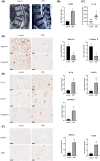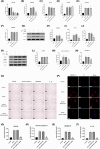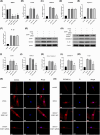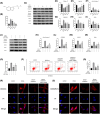Melatonin mitigates intervertebral disc degeneration by suppressing NLRP3 inflammasome activation via the EGR1/DDX3X pathway
- PMID: 39708233
- PMCID: PMC11670809
- DOI: 10.1096/fj.202302453RRR
Melatonin mitigates intervertebral disc degeneration by suppressing NLRP3 inflammasome activation via the EGR1/DDX3X pathway
Abstract
Intervertebral disc degeneration (IVDD), is one of the leading causes of low back pain. Inflammation is considered to be the main pathophysiological process of IVDD. The nucleotide-binding domain and leucine-rich pyrin domain containing 3 (NLRP3) inflammasome-mediated inflammatory responses are critically involved in the progression of IVDD. Melatonin is known for its anti-inflammatory and antioxidant effects. However, little is known about the potential effects of melatonin in the pathological process of IVDD. We found that the expression of EGR1, DDX3X, and NLRP3 inflammasome increased and extracellular matrix (ECM) degraded in IVDD. With the application of EGR1 siRNA, the expression of DDX3X and the activation of NLRP3 inflammasome were inhibited in stress-induced NP cells. DDX3X/NLRP3 was regulated on dependence of EGR1. Besides, the utility of melatonin mitigated the EGR1-induced overproduction of DDX3X and activation of NLRP3 inflammasome, thus protecting cells from pyroptosis and ECM degradation. In vivo, in a rat IVDD model, melatonin was found to be able to delay the development of IVDD by imageological and histological evaluation. In conclusion, our study demonstrated that melatonin prevented IVDD progression by regulating EGR1/DDX3X/NLRP3 axis. Our study provides insight into melatonin as a new target for therapeutic approaches for IVDD.
Keywords: DDX3X; EGR1; NLRP3 inflammasome; intervertebral disc degeneration; melatonin; nucleus pulposus.
© 2024 Federation of American Societies for Experimental Biology.
Figures







Similar articles
-
Propionibacterium acnes induces intervertebral disc degeneration by promoting nucleus pulposus cell pyroptosis via NLRP3-dependent pathway.Biochem Biophys Res Commun. 2020 Jun 4;526(3):772-779. doi: 10.1016/j.bbrc.2020.03.161. Epub 2020 Apr 4. Biochem Biophys Res Commun. 2020. PMID: 32265028
-
SOX4 accelerates intervertebral disc degeneration via EZH2/NRF2 pathway in response to mitochondrial ROS-dependent NLRP3 inflammasome activation in nucleus pulposus cells.J Transl Med. 2025 Apr 3;23(1):395. doi: 10.1186/s12967-024-05913-1. J Transl Med. 2025. PMID: 40181390 Free PMC article.
-
Acid-sensing ion channels regulate nucleus pulposus cell inflammation and pyroptosis via the NLRP3 inflammasome in intervertebral disc degeneration.Cell Prolif. 2021 Jan;54(1):e12941. doi: 10.1111/cpr.12941. Epub 2020 Oct 27. Cell Prolif. 2021. PMID: 33111436 Free PMC article.
-
Roles of NLRP3 inflammasome in intervertebral disc degeneration.Osteoarthritis Cartilage. 2021 Jun;29(6):793-801. doi: 10.1016/j.joca.2021.02.204. Epub 2021 Feb 18. Osteoarthritis Cartilage. 2021. PMID: 33609693 Review.
-
Molecular Mechanisms of Intervertebral Disc Degeneration Induced by Propionibacterium acnes.Biomed Res Int. 2025 Apr 15;2025:5513856. doi: 10.1155/bmri/5513856. eCollection 2025. Biomed Res Int. 2025. PMID: 40264644 Free PMC article. Review.
Cited by
-
Melatonin in Glaucoma: Integrative Mechanisms of Intraocular Pressure Control and Neuroprotection.Biomedicines. 2025 May 16;13(5):1213. doi: 10.3390/biomedicines13051213. Biomedicines. 2025. PMID: 40427040 Free PMC article. Review.
-
Progress of melatonin in the treatment of intervertebral disc degeneration.Front Physiol. 2025 May 14;16:1529315. doi: 10.3389/fphys.2025.1529315. eCollection 2025. Front Physiol. 2025. PMID: 40438255 Free PMC article. Review.
-
Comparative Analysis of Melatonin and Polydeoxyribonucleotide: Possible Benefits of Co-Treatment Effects and Potential Synergistic Applicability.Int J Mol Sci. 2025 Jun 13;26(12):5703. doi: 10.3390/ijms26125703. Int J Mol Sci. 2025. PMID: 40565167 Free PMC article. Review.
-
Melatonin as an anti-inflammatory hormone bridging migraine relief and cancer immunity enhancement: a literature review.Front Immunol. 2025 Jul 28;16:1644066. doi: 10.3389/fimmu.2025.1644066. eCollection 2025. Front Immunol. 2025. PMID: 40791587 Free PMC article. Review.
References
-
- Yang S, Zhang F, Ma J, Ding W. Intervertebral disc ageing and degeneration: the antiapoptotic effect of oestrogen. Ageing Res Rev. 2020;57:100978. - PubMed
MeSH terms
Substances
Grants and funding
LinkOut - more resources
Full Text Sources
Miscellaneous

